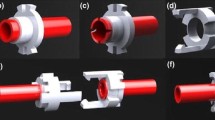Abstract
In this work, an innovative vascular coupling device (VCD) is created to realize quick and reliable vessel anastomosis. Vessel anastomosis is common and often necessary during trauma, replantation and free tissue transfer surgeries. The current method of vessel anastomosis is traditional hand suturing. This technique is time consuming (20–30 min), difficult, and requires complex instruments. Additionally, it requires very skilled surgeons to efficiently perform the operation. To improve the reliability and reduce the amount of time required to connect two vessels, while providing an intima-to-intima anastomosis with no foreign material in contact with the blood flow, as occurs with sutures, a series of VCDs ranging from 1.5 mm to 7 mm inner diameter are designed and fabricated from polytetrafluoroethylene (PTFE) using laser cutting. A set of installation tools are also designed and fabricated to facilitate the VCD application. A series of experiments to test the VCD functionality are performed using both latex tubes and arteries. The results showed that the anastomosis process using VCDs and the installation tools can be completed in 5 min. The coupled VCDs can withstand 20 N tensile force, which is much higher than normal physiology conditions. There is no leakage or significant effects of the VCDs on the flow. A Micro-CT scan and histology images of cadaver arteries coupled with VCDs demonstrated that the VCD keeps the vessels open and does not constrict blood flow, suggesting that the VCD could be used in more advanced testing.












Similar content being viewed by others
References
N. Chernichenko, D.A. Ross, J. Shin, J.Y. Chow, C.T. Sasaki, S. Ariyan, Arterial coupling for microvascular free tissue transfer. Otolaryngol. Head Neck Surg. 138, 614–618 (2008)
A.K. Dubey, V. Yadava, Laser beam machining—A review. J Mach Tool Manu 48, 609–628 (2008)
E. Ferrari, P. Tozzi, L.K. von Segesser, The Vascular Join: a new sutureless anastomotic device to perform end-to-end anastomosis. Preliminary results in an animal model. Interact. Cardiovasc. Thorac. Surg. 6, 5–8 (2007)
F. Filsoufi, R.S. Farivar, L. Aklog, C.A. Anderson, R.H. Chen, S. Lichtenstein, J. Zhang, D.H. Adams, Automated distal coronary bypass with a novel magnetic coupler (MVP system). J. Thorac. Cardiovasc. Surg. 127, 185–192 (2004)
M.D. Gardiner, J. Nanchahal, Strategies to ensure success of microvascular free tissue transfer. J. Plast. Reconstr. Aesthet. Surg. 63, 665–673 (2010)
J.F. Gummert, U. Opfermann, S. Jacobs, T. Walther, J. Kempfert, F.W. Mohr, V. Falk, Anastomotic devices for coronary artery bypass grafting: technological options and potential pitfalls. Comput. Biol. Med. 37, 1384–1393 (2007)
S. Jacobs, F.W. Mohr, V. Falk, Facilitated endoscopic beating heart coronary bypass grafting using distal anastomotic device. Int. Congr. Ser. 1268, 809–812 (2004)
T. Khamdaeng, J. Luo, J. Vappou, P. Terdtoon, E.E. Konofagou, Arterial stiffness identification of the human carotid artery using the stress–strain relationship in vivo. Ultrasonics 52, 402–411 (2012)
U. Klima, M. Maringka, E. Bagaev, S. Kirschner, A. Haverich, Total magnetic vascular coupling for arterial revascularization. J. Thorac. Cardiovasc. Surg. 127, 602–603 (2004)
C. Lally, A.J. Reid, P.J. Prendergast, Elastic behavior of porcine coronary artery tissue under uniaxial and equibiaxial tension. Ann. Biomed. Eng. 32, 1355–1364 (2004)
C. Reddy, D. Pennington, H. Stern, Microvascular anastomosis using the vascular closure device in free flap reconstructive surgery: a 13-year experience. J. Plast. Reconstr. Aesthet. Surg. 65, 195–200 (2012)
D.A. Ross, J.Y. Chow, J. Shin, R. Restifo, J.K. Joe, C.T. Sasaki, S. Ariyan, Arterial coupling for microvascular free tissue transfer in head and neck reconstruction. Arch. Otolaryngol. Head Neck Surg. 131, 891–895 (2005)
M.L. Shindo, P.D. Costantino, V.P. Nalbone, D.H. Rice, U.K. Sinha, Use of a mechanical microvascular anastomotic device in head and neck free tissue transfer. Arch. Otolaryngol. Head Neck Surg. 122, 529–532 (1996)
J.S. Scheltes, C.J. van Andel, P.V. Pistecky, C. Borst, Coronary anastomotic devices: blood-exposed non-intimal surface and coronary wall stress. J. Thorac. Cardiovasc. Surg. 126, 191–199 (2003)
G. Sommer, P. Regitnig, L. Költringer, G.A. Holzapfel, Biaxial mechanical properties of intact and layer-dissected human carotid arteries at physical and supraphysical loadings. Am. J. Physiol. Heart Circ. Physiol. 298, 898–912 (2010)
J.A. Spector, L.B. Draper, J.P. Levine, C.Y. Ahn, Routine use of microvascular coupling device for arterial anastomosis in breast reconstruction. Ann. Plast. Surg. 56, 365–368 (2006)
W.J. Suyker, M.P. Buijsrogge, P.T. Suyker, C.W. Verlaan, C. Borst, P.F. Grundeman, Stapled coronary anastomosis with minimal intraluminal artifact: the S2 Anastomotic System in the off-pump porcine model. J. Thorac. Cardiovasc. Surg. 127, 498–503 (2004)
C.J. van Andel, P.V. Pistecky, C. Borst, Mechanical properties of porcine and human arteries: implications for coronary anastomotic connectors. Ann. Thorac. Surg. 76, 58–64 (2003a)
C.J. van Andel, P.V. Pistecky, P.F. Gründeman, M.P. Buijsrogge, C. Borst, Permanent wall stretching in porcine coronary and internal mammary arteries. Ann. Thorac. Surg. 76, 805–809 (2003b)
K. Yajima, Y. Yamamoto, K. Nohira, Y. Shintomi, P.N. Blondeel, M. Sekido, W. Mol, M. Ueda, T. Sugihara, A new technique of microvascular suturing: the chopstick rest technique. Br. J. Plast. Surg. 57, 567–571 (2004)
J. Zdolsek, H. Ledin, D. Lidman, Are mechanical microvascular anastomoses easier to learn than suture anastomoses? Microsurgery 25, 596–598 (2005)
Acknowledgments
The authors would like to acknowledge the financial support of Technology Commercialization Project, University of Utah.
Author information
Authors and Affiliations
Corresponding authors
Rights and permissions
About this article
Cite this article
Gehrke, C., Li, H., Sant, H. et al. Design, fabrication and testing of a novel vascular coupling device. Biomed Microdevices 16, 173–180 (2014). https://doi.org/10.1007/s10544-013-9819-z
Published:
Issue Date:
DOI: https://doi.org/10.1007/s10544-013-9819-z




